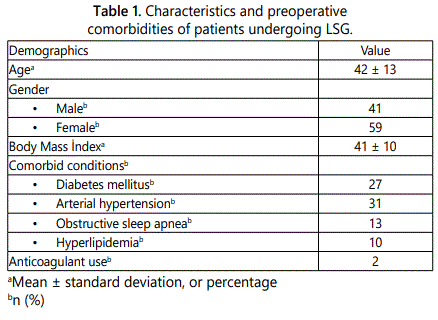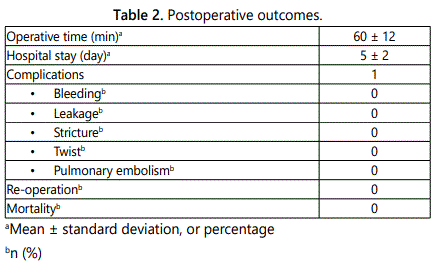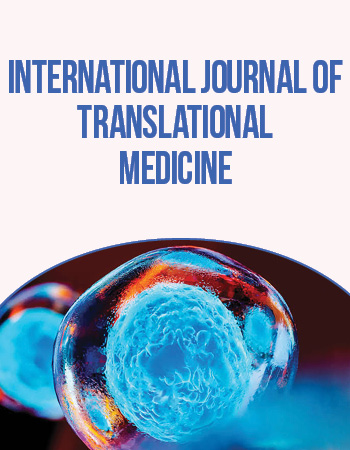Research Article
Effects and Results of Fıbrın Sealent use in Laparoscopıc Sleevegastrectomy
General Surgery Specialist, Department of General Surgery, Van Educational and Research Hospital, Van, Turkey
*Corresponding author: Mehmet Kadir Bartin, General Surgery Specialist, Department of General Surgery, Van Educational and Research Hospital, Van, Turkey, Tel: +905054881787, E-mail: surgeon65@hotmail.com
Received: April 8, 2019 Accepted: April 30, 2019 Published: May 7, 2019
Citation: Oner MO, Bartın MK. Effects and Results of Fıbrın Sealent use in Laparoscopıc Sleevegastrectomy. Int J Transl Med. 2019; 1(1): 8-10. doi: 10.18689/ijtm-1000103
Copyright: © 2019 The Author(s). This work is licensed under a Creative Commons Attribution 4.0 International License, which permits unrestricted use, distribution, and reproduction in any medium, provided the original work is properly cited.
Abstract
Background: Leakage and bleeding after LSG are very serious feared complications. The aim of this study was to review the clinical evidence after using fibrin sealant in standard LSG.
Methods: Morbidly obese patients who underwent standard technique of LSG with using fibrin sealant were included in the study. Data concerning patient demographic variables [age, gender, body mass index (BMI, kg/m2), and comorbid conditions], previous surgeries, postoperative complications and postoperative readmissions were collected.
Results: In total, 100 patients who underwent LSG, 51.6% of the patients had obesityrelated comorbid conditions with a BMI>35 kg/m2. The mean age of the patients was 42 ± 13 years. All operations were completed laparoscopically. The mean operative time was 60 ± 12 min. No leakage was detected in the intra-operative methylene blue test. The mean hospital stay was 5 ± 2 days. Staple-line leakage, twist and stricture were not observed. No mortality were noted.
Conclusion: This retrospective study shows that bariatric surgeons should consider using standard surgical surgery in LSG to reduce postoperative complications. Fibrin glue is a reliable and useful tool for strengthening the staple line and can prevent potential twist of the stomach.
Keywords: Laparoscopy; Sleevegastrectomy; Fıbrın Sealent.
Introduction
In recent years, bariatric and metabolic surgeries have been increasingly used to reduce obesity-related comorbidities and for weight loss. Bariatric surgery is applied to patients with a body mass index of 40 kg/m2 or BMI ≥ 35 with diabetes, ht, dyslipidemia and sleep apnea. LGS (laparoscopic sleeve gastrectomy), which is one of the bariatric surgical methods, is a simple technique and has a shorter learning curve and is a widely used surgical method for the treatment of morbid obesity [1-3]. The most important complication is the presence of bleeding and leakage in the stapler line in the postop period due to increased intragastric pressure [4-7]. The reported incidence of leak after LSG varies between 0% and 5.5% and patients with leaks are prone to local or systemic severe complications [1,5]. Prevention of leaks in patients undergoing LSG is of significant importance with regard to reducing mortality and morbidity as well as reducing the costs associated with the treatment of leaks [4]. Materials and methods that can be used to reduce the risk of leaks are still a matter of discussion [8,9]. Materials that have been previously used for the reinforcement of the staple line include bioprosthetic materials such as fibrin glue or bovine pericardium strips or absorbable polymer membranes [9-11]. However, there are very few studies examining the relative efficacy of these methods in reducing the leak risk [11]. In this study, we retrospectively revievwed efficacy of tissel tissue glue to prevent bleeding and stapler line.
Materials and Methods
İn our study, 100 patients who underwent LGS in General Surgery Clinic of S.B.Ü Van Training and Research Hospital between January 2015 and June 2018 were retrospectively assessed. Informed consent was obtained from all patients. Data concerning patient demographic variables [age, gender, body mass index (BMI, kg/m2), and comorbid conditions], previous surgeries, postoperative complications and postoperative readmissions were collected. In order to prevent thrombo-embolism, all patients were administered 1-2 mg/kg subcutaneous low-molecular-weight heparin before and after surgery. Standard LSG was performed and all patients were sprayed with two 4 ml boxes of human fibrin sealant (tissel™, Boxter @ deerfield, IL, USA) along the suture line.
In the first follow-up month, complications were determined. Continuous variables were expressed as the mean ± standard deviation. Categorical variables were expressed as frequencies After surgical cessation of the stomach with the help of laparoscopic staplers throughout the large curvature during the standard LSG operation as a surgical procedure two boxes (8 ml) of human fibrin sealant was sprayed with a special laparoscopic set along the stapler line to provide hemostasis, sealing and adhesion.
Results
Of the 100 patients who underwent LSG, 51.6% of the patients had obesity-related comorbid conditions with a BMI>35 kg/m2. The mean age of the patients was 42 ± 13 years. Demographic and anthropometric variables and types of comorbid conditions are provided in table 1. All operations were completed laparoscopically. The mean operative time was 60 ± 12 min. No leakage was detected in the intra-operative methylene blue test. The mean hospital stay was 5 ± 2 days.

Postoperative complications are shown in table 2. One patient presented with abdominal pain after discharge and was treated with medical treatment. The patient did not require any intervention and there was no mortality. The bleeding rate was 1%, and bleeding was spontaneously stopped by clinical follow-up. On postoperative day 6, the patient was discharged. There were no other complications in the first follow-up period of all operated patients.

Discussion
Bariatric surgery, especially sleeve gastrectomy, obesity and related diseases caused by obesity-related deaths has been reduced [1,12,13]. LSG is associated with post op increased intragastic pressure and we believe that fibrin adhesive materials reduce the rate of leakage by increasing resistance to this increased pressure [4]. Today, the LSG has become comparable with other procedures with its advantages and effective results. However, a very serious complication may occur due to the surgical technique. All surgeons aim to reduce the risk of complications; therefore, most surgeons use various materials to provide hemostasis and strengthen the staple line. But no material was used to prevent gastric tube rotation and/or stricture [1]. In our standard technique, if the stomach divided straight and human fibrin sealant was sprayed on the staple line, left crus of the diaphragm and posterior of the stomach, then the surrounding tissues adhered to the gastric tube. In the literature, the rate of staple-line leak and stricture following LSG ranged from 0-4.2% [14-16] and 0-2.1% [17-19]. These complications were shown as the major cause of mortality and morbidity. Bleeding, which is another complication observed after LSG, has been shown to vary between 1.7% and 13.7% in the literature [19-21]. Numerous options to prevent bleeding according to our findings, abdominal hemorrhage after LSG should be followed carefully with proper hydration, including erythrocyte suspensions. Hemodynamically stable patients should not be in a hurry for surgery as much as possible. However, patients who do not achieve hemodynamic improvement despite appropriate hydration and ES replacement should be operated [1]. So why do we use tissel. Tisseel may be dissolved after a while and its contents partially prevent the bleeding. We did not use this agent to prevent leakage directly. However, we think that Tissel helps to prevent leaks by allowing the omentum to stick to the stapler line with the effect of tissue adhesive. Our study is a retrospective study and it is a limited study because there are no comparative control groups. We also think that the number of patients is insufficient to achieve statistically significant results. We think that more comprehensive studies are needed.
Conclusion
Various approaches to reduce the complication rate; synthetic or biological reinforcement materials have been used but there is no consensus on this subject. Fibrin sealant is a reliable and useful tool to reinforce the staple line and may prevent twists in the sleeved stomach.
Ethics
Compliance with ethical standards.
Disclosures
Dr. Muzaffer Önder Öner and Dr. Mehmet Kadir Bartın have no conflicts of interest or financial ties to disclose.
References
- Coşkun H, Yardimci E. Effects and results of fibrin sealant use in 1000 laparoscopic sleeve gastrectomy cases. Surg Endosc. 2017; 31(5): 2174-2179. doi: 10.1007/s00464-016-5215-0
- Glatt D, Sorenson T. Metabolic and bariatric surgery for obesity: a review. S D Med. 2011; 57–62.
- DʼHondt M, Vanneste S, Pottel H, Devriendt D, Van Rooy F, Vansteenkiste F. Laparoscopic sleeve gastrectomy as a single-stage procedure for the treatment of morbid obesity and the resulting quality of life, resolution of comorbidities, food tolerance, and 6-year weight loss. Surg Endosc. 2011; 25(8): 2498–2504. doi: 10.1007/s00464-011-1572-x
- Usta S, Karabulut K. Effect of fibrin glue or suture on leakage in patients undergoing laparoscopic sleeve gastrectomy. Niger J Clin Pract. 2018; 21(9): 1209-1212. doi: 10.4103/njcp.njcp_306_17
- Fernandez AZ, Luthra AK, Evans JA. Endoscopic closure of persistent gastric leak and fistula following laparoscopic sleeve gastrectomy. Int J Surg Case Rep. 2015; 6C: 186-187. doi: 10.1016/j.ijscr.2014.11.077
- Knapps J, Ghanem M, Clements J, Merchant AM. A systematic review of staple-line reinforcement in laparoscopic sleeve gastrectomy. JSLS. 2013; 17: 390-399. doi: 10.4293/108680813X13654754534639
- Aurora AR, Khaitan L, Saber AA. Sleeve gastrectomy and the risk of leak: a systematic analysis of 4888 patients. Surg Endosc. 2012; 26: 1509–1515. doi: 10.1007/s00464-011-2085-3
- Musella M, Milone M, Maietta P, Bianco P, Pisapia A, Gaudioso D. Laparoscopic sleeve gastrectomy: efficacy of fibrin sealent in recuing postoperative bleeding. A randomized controlled trial. Updates Surg. 2014; 66(3): 197–201. doi: 10.1007/s13304-014-0257-0
- Bransen J, Gilissen LP, van Rutte PW, Nienhuijs SW. Costs of leaks and bleeding after sleeve gastrectomies. Obes Surg. 2015; 25(10): 1767-1771. doi: 10.1007/s11695-015-1584-z
- Gagner M, Buchwald JN. Comparison of laparoscopic sleeve gastrectomy leak rates in four staple-line reinforcement options: A systematic review. Surg Obes Relat Dis. 2014; 10(4): 713-723. doi: 10.1016/j.soard.2014.01.016
- Barreto TW, Kemmeter PR, Paletta MP, Davis AT. A comparison of a single centerʼs experience with three staple line reinforcement techniques in 1,502 laparoscopic sleeve gastrectomy patients. Obes Surg. 2015; 25: 418-422. doi: 10.1007/s11695-014-1432-6
- Sjöström L, Narbro K, Sjöström CD, et al. Effects of bariatric surgery on mortality in Swedish obese subjects. N Engl J Med. 2007; 357: 741–752. doi: 10.1056/NEJMoa066254
- Arterburn DE, Olsen MK, Smith VA, et al. Association between bariatric surgery and long-term survival. JAMA. 2015; 313(1): 62–70. doi: 10.1001/jama.2014.16968
- Albanopoulos K, Alevizos L, Flessas J, et al. Reinforcing the staple line during laparoscopic sleeve gastrectomy: prospective randomized clinical study comparing two different techniques. Preliminary results. Obes Surg. 2012; 22(1): 42–46. doi: 10.1007/s11695-011-0421-2
- Helmiö M, Victorzon M, Ovaska J, et al. SLEEVEPASS: a randomized prospective multicenter study comparing laparoscopic sleeve gastrectomy and gastric bypass in the treatment of morbid obesity: preliminary results. Surg Endosc. 2012; 26: 2521–2526. doi: 10.1007/s00464-012-2225-4
- Catheline JM, Fysekidis M, Bachner I, et al. Five-year results of sleeve gastrectomy. J Visc Surg. 2013; 150(5): 307–312. doi: 10.1016/j.jviscsurg.2013.08.008
- Chopra A, Chao E, Etkin Y, Merklinger L, Lieb J, Delany H. Laparoscopic sleeve gastrectomy for obesity: can it be considered a definitive procedure? Surg Endosc. 2012; 26: 831–837. doi: 10.1007/s00464-011-1960-2
- Zachariah SK, Chang PC, Ooi AS, Hsin MC, Kin Wat JY, Huang CK. Laparoscopic sleeve gastrectomy for morbid obesity: 5 years experience from an Asian center of excellence. Obes Surg. 2013; 23(7): 939–946. doi: 10.1007/s11695-013-0887-1
- Gentileschi P, Camperchioli I, DʼUgo S, Benavoli D, Gaspari AL. Staple-line reinforcement during laparoscopic sleeve gastrectomy using three different techniques: a randomized trial. Surg Endosc. 2012; 26(9): 2623–2629. doi: 10.1007/s00464-012-2243-2
- Basso N, Casella G, Rizzello M, et al. Laparoscopic sleeve gastrectomy as first stage or definitive intent in 300 consecutive cases. Surg Endosc. 2011; 25(2): 444–449. doi: 10.1007/s00464-010-1187-7
- DʼUgo S, Gentileschi P, Benavoli D, et al. Comparative use of different techniques for leak and bleeding prevention during laparoscopic sleeve gastrectomy: a multicenter study. Surg Obes Relat Dis. 2014; 10(3): 450–454. doi: 10.1016/j.soard.2013.10.018


